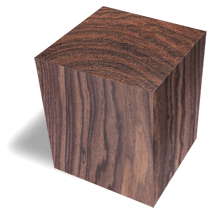
Kingwood
Kingwood, scientifically Dalbergia cearensis, is a rare tropical hardwood from the rosewood family (Fabaceae), native to Brazil, particularly in the northeastern regions like Ceará, where it’s also known as “Violeta.” It’s a small tree, typically growing to 30–50 feet tall with a trunk diameter of 6–12 inches, often found in dry forests or savanna-like environments. Its small size and slow growth contribute to its scarcity.
The heartwood of Kingwood is renowned for its stunning appearance, displaying a rich, deep purple to reddish-brown base with dramatic black or dark violet streaks that create a striking contrast—hence its historical nickname “Violet Wood.” The sapwood is a pale cream or yellowish-white, sharply distinct. The grain is usually straight to slightly interlocked, with a very fine, even texture and a high natural lustre that gives it a polished, almost gem-like quality when finished. The wood’s colour deepens over time with exposure to light, enhancing its regal appearance.
Kingwood has a density of around 950–1,200 kg/m³, making it extremely hard, heavy, and durable, with excellent stability once seasoned. It’s highly resistant to decay, moisture, and insects, thanks to its natural oils, which also give it a smooth, waxy feel. These oils can make gluing challenging—degreasing with a solvent like alcohol is recommended—and may affect some finishes, though oil-based or wax finishes work well. Kingwood machines and turns beautifully, but its hardness dulls tools quickly, and its fine dust can be an irritant, potentially causing allergic reactions like dermatitis in some individuals.
When worked, Kingwood emits a mild, sweet, and floral aroma, typical of rosewoods, which can linger subtly in the finished piece. It’s historically prized for fine furniture, particularly in 18th-century French marquetry, where it was used for intricate inlays and veneers, earning its name “Kingwood” due to its association with royalty. In the UK, it’s used for high-end cabinetry, turned objects like pens or knife handles, and small decorative items such as jewellery boxes, where its vibrant colour and fine grain can be showcased. It’s also valued in musical instruments, like guitar fingerboards, for its tonal clarity and aesthetic appeal.
Kingwood is very expensive and rare due to its limited supply and small tree size. It’s listed on CITES Appendix II, as part of the Dalbergia genus, and Dalbergia cearensis is considered vulnerable by the IUCN due to overharvesting and habitat loss in Brazil. In the UK, it’s typically used sparingly in bespoke craftsmanship, where its luxurious appearance justifies the cost, but sustainable sourcing or alternatives like other rosewoods are often considered to reduce pressure on wild populations.
